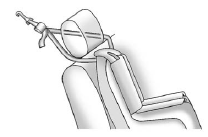 GMC Terrain: Securing a Child Restraint Designed for the LATCH System
GMC Terrain: Securing a Child Restraint Designed for the LATCH System
WARNING
If a LATCH-type child restraint is not attached to anchors, the child restraint will not be able to protect the child correctly. In a crash, the child could be seriously injured or killed. Install a LATCH-type child restraint properly using the anchors, or use the vehicle safety belts to secure the restraint, following the instructions that came with the child restraint and the instructions in this manual.
WARNING
Do not attach more than one child restraint to a single anchor. Attaching more than one child restraint to a single anchor could cause the anchor or attachment to come loose or even break during a crash. A child or others could be injured. To reduce the risk of serious or fatal injuries during a crash, attach only one child restraint per anchor.
Children can be seriously injured or strangled if a shoulder belt is wrapped around their neck and the safety belt continues to tighten. Buckle any unused safety belts behind the child restraint so children cannot reach them. Pull the shoulder belt all the way out of the retractor to set the lock, if the vehicle has one, after the child restraint has been installed.
Notice: Do not let the LATCH attachments rub against the vehicle’s safety belts. This may damage these parts. If necessary, move buckled safety belts to avoid rubbing the LATCH attachments.
Do not fold the empty rear seat with a safety belt buckled. This could damage the safety belt or the seat. Unbuckle and return the safety belt to its stowed position, before folding the seat. Make sure to attach the child restraint at the proper anchor location.
This system is designed to make installation of child restraints easier. When using lower anchors, do not use the vehicle's safety belts. Instead use the vehicle's anchors and child restraint attachments to secure the restraints. Some restraints also use another vehicle anchor to secure a top tether.
1. Attach and tighten the lower attachments to the lower anchors. If the child restraint does not have lower attachments or the desired seating position does not have lower anchors, secure the child restraint with the top tether and the safety belts. Refer to the child restraint manufacturer instructions and the instructions in this manual.
1.1. Find the lower anchors for the desired seating position.
1.2. Put the child restraint on the seat.
1.3. Attach and tighten the lower attachments on the child restraint to the lower anchors.
2. If the child restraint manufacturer recommends that the top tether be attached, attach and tighten the top tether to the top tether anchor, if equipped. Refer to the child restraint instructions and the following steps:
2.1. Find the top tether anchor.
2.2. Route, attach and tighten the top tether according to your child restraint instructions and the following instructions:

○ If the position being used does not have a headrest or head restraint and a single tether is being used, route the tether over the seatback.

○ If the position being used does not have a headrest or head restraint and a dual tether is being used, route the tether over the seatback.

○ If the position being used has a fixed headrest or head restraint and a dual tether is being used, route the tether around the headrest or head restraint.

○ If the position being used has a fixed headrest or head restraint and a single tether is being used, route the tether over the headrest or head restraint.
3. Before placing a child in the child restraint, make sure it is securely held in place. To check, grasp the child restraint at the LATCH path and attempt to move it side&-to&-side and backand&- forth. There should be no more than 2.5 cm (1 in) of movement, for proper installation.
 Lower Anchor and Top Tether Anchor Locations
Lower Anchor and Top Tether Anchor Locations
Rear Seat
(Top Tether Anchor): Seating positions
with top tether anchors.
(Lower Anchor): Seating positions
with two lower anchors.
The rear outboard seating positions have exposed metal anch ...
 Replacing LATCH System Parts After a Crash
Replacing LATCH System Parts After a Crash
WARNING
A crash can damage the LATCH system in the vehicle. A damaged LATCH system may
not properly secure the child restraint, resulting in serious injury or even death
in a crash. To help make ...
See also:
The rear view monitor system can be operated when
Vehicles without smart key system
The shift lever is in R, the back door is fully closed and the engine switch
is
in the “ON” position.
Vehicles with smart key system
The shift lever is in R ...
Audio/Video (A/V) Jacks
If available, the A/V jacks are located on the rear of the floor console. They
allow audio or video cables to be connected from an auxiliary device such as a camcorder
or a video game system. The ...
Detachable key blade
Each remote key or PCC contains a detachable
metal key blade for mechanically locking or
unlocking the driver's door and the glove compartment.
See page 61 for more information
on the key blade ...
